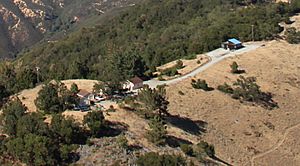Fremont Peak Observatory facts for kids
Quick facts for kids Fremont Peak Observatory |
|||||
|---|---|---|---|---|---|

Fremont Peak Observatory viewed from Fremont Peak
|
|||||
| Organization | Fremont Peak Observatory Association | ||||
| Location | Fremont Peak State Park | ||||
|
Coordinates
|
36°45′36.8″N 121°29′55.4″W / 36.760222°N 121.498722°W
|
||||
| Altitude | 838 meters (2749 feet) | ||||
| Established | 1986 | ||||
|
|||||
The Fremont Peak Observatory (FPOA) is a special place where people study stars and space. It's owned and run by the Fremont Peak Observatory Association. Built in 1986, you can find it inside Fremont Peak State Park, close to San Juan Bautista, California. This observatory is home to a very powerful telescope called the Challenger.
Contents
History of the Observatory
The observatory gets its name from the mountain it sits on, Fremont Peak. This mountain was named after an American explorer and U.S. Army Captain, John C. Frémont. Before that, the peak was called Gabilan Peak, which is a Spanish word for hawk. The California state park service bought the peak in 1936.
How the Observatory Started
The first group to use the peak for stargazing was the San Mateo Astronomical Society in the late 1960s. This spot was great for amateur astronomers. They could see above the fog and away from city lights in Monterey County. Many groups from the North Bay Area loved coming here.
Volunteers worked hard and raised $25,000. They also received equipment donated by Celestron, a company that makes telescopes. With all this help, the Fremont Peak Observatory Association was formed. It's now a non-profit group. The observatory officially opened its doors in 1986.
Improvements Over Time
In 2003, the State Park Department made some big improvements to the observatory area. They removed four large trees that were blocking the view of the southern sky. New roads, special viewing pads with power outlets, and safe, dim lights were added. A large open area was also created on the west side of the observatory.
In 2009, the Fremont Peak Observatory faced a challenge. Due to money problems in California, the park's operating hours were reduced. Doug Brown, who was the president of FPOA at the time, mentioned that the park needed support to stay open.
'We teach people about astronomy, and what is out in the universe and where are we in it, as well some of the history and dynamics of what's going on out there.' – Doug Brown, FPOA President, 2015
The Challenger Telescope
The main telescope at the observatory is called the Challenger. It's a very large telescope, with a mirror that is 30 inches (about 76 cm) across. It's known as "one of the largest telescopes available for public use."
Kevin and Denni Medlock from the Eastbay Astronomical Society built this telescope in the early 1980s. They even ground the mirror and built the entire telescope in their garage! The Challenger telescope first saw light from space in 1986.
This telescope is very heavy, weighing about one ton. It sits in a room that's about the size of a classroom. An intern named Edwin Levin explained that the mirror itself weighs 250 pounds (about 113 kg). It's bolted deep into solid concrete, all the way down to the bedrock of the mountain. A small motor helps the telescope move slowly. This motor matches the speed of Earth's rotation, keeping the telescope pointed at the same object in the sky.
After a program in the observatory's meeting room, the roof rolls back, the telescope is pointed at the sky, and you are transported from Earth to outer space as planets, nebulae, star clusters, double stars, and other deep sky objects appear. – Doris Sloan
Cameras for Meteor Watching
NASA astronomer Peter Jenniskens announced that the FPOA is part of a project called Cameras for Allsky Meteor Surveillance (CAMS). This project uses cameras to map out meteor showers as they happen.
Viewing a Lunar Impact (2009)
In October 2009, the FPOA held a special "impact party." More than fifty people came to watch an event that was supposed to happen at 4:30 AM. NASA planned to crash a rocket into the Moon. They hoped this would create a cloud of dust that astronomers could see with medium-sized telescopes.
NASA said their experiment was a success. However, observers at Fremont Peak Observatory were not able to see the impact. Even though they were a bit disappointed, the people who came were "good sports," according to Dave Samuels, the Vice-President of FPOA. He said everyone learned something, and it was "worth coming and being a part of something that was going on."
How the Observatory Works
The Fremont Peak Observatory is run entirely by trained volunteers. For several years, they have also had an intern program. This program helps science students from nearby Hartnell College gain experience.
The observatory usually holds public viewing programs from April through October. These events happen on Saturday nights when the Moon is not full, so the sky is darker.
If you plan to visit, it's a good idea to check the weather first. Clouds or rain might cause programs to be canceled. Visitors should arrive before sunset. Also, please do not use bright flashlights unless they are covered. Bright lights can disturb other visitors who are trying to see the stars.

